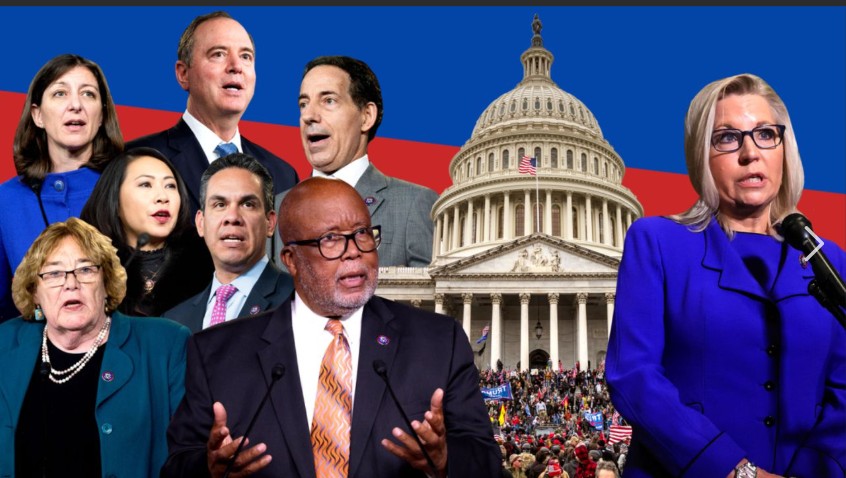JAN6 COMMITTEE HID EXCULPATORY EVIDENCE EXONORATING TRUMP

TREASONOUS JANUARY 6 COMMITTEE MEMBERS THAT HID EXCULPATORY EVIDENCE
BY THE LEGAL EAGLE
It has recently come to light that several key figures in the January 6 Committee, Nancy Pelosi and Liz Cheney primary, with the help of several others are implicated in hiding and destroying critical evidence that could have exonerated former President Donald Trump.
According to an interim report released about the committee’s investigation, Pelosi and Cheney’s actions severely undermined the integrity of the inquiry.
The report outlines how the two women deliberately concealed exculpatory evidence, which would have cleared Trump of any wrongdoing related to the events of January 6, 2021.
Evidence supporting the notion that Trump had no direct involvement in the planning or execution of the Capitol riot was allegedly destroyed, further complicating the public’s understanding of what truly transpired that day.
This new revelation raises serious concerns about the committee’s intentions and the broader political motivations behind its investigation. While the committee was formed with the goal of uncovering the truth about the events surrounding January 6, the interim report claims that certain members, including Pelosi and Cheney, were more interested in building a case against the former president than in conducting a fair and impartial investigation. The evidence that was concealed could have cleared Trump of any charges related to incitement or conspiracy. By withholding or destroying this evidence, the committee not only obstructed justice but also undermined the very premise of a transparent inquiry.
The interim report also highlights claims of witness tampering and collusion among key members of the committee. It appears that Pelosi and Cheney worked behind the scenes to influence testimony, encouraging certain witnesses to provide damaging statements against Trump while silencing others who might have spoken in his defense. This coordinated effort to shape the narrative suggests that the investigation was not about uncovering the truth, but rather about manufacturing a case against the former president, even if it meant bending or breaking the law in the process.
Further compounding the controversy is the connection between the committee’s actions and the discredited Steele dossier, which was purchased by Hillary Clinton’s campaign. The interim report outlines how, after the Steele dossier failed to provide sufficient grounds for the case against Trump, some committee members resorted to drastic measures to continue painting him as guilty. By hiding evidence that could have exonerated Trump and framing their inquiry around a narrative of culpability, Pelosi and Cheney appear to have been influenced by political motives rather than a desire for truth or justice.
The implications of these findings are far-reaching, as they call into question the entire legitimacy of the January 6 Committee’s work. If Pelosi and Cheney were indeed involved in destroying evidence, manipulating witnesses, and colluding to advance a politically motivated narrative, the entire investigation may have been nothing more than a partisan effort to undermine Trump’s reputation and legacy. The interim report lays the groundwork for a broader investigation into these claims, which could result in legal and political repercussions for those involved in this apparent cover-up. The full impact of these revelations is yet to be seen, but they add another layer of complexity to the already contentious aftermath of January 6.





 Afrikaans
Afrikaans Albanian
Albanian Amharic
Amharic Arabic
Arabic Armenian
Armenian Azerbaijani
Azerbaijani Basque
Basque Belarusian
Belarusian Bengali
Bengali Bosnian
Bosnian Bulgarian
Bulgarian Catalan
Catalan Cebuano
Cebuano Chinese (Simplified)
Chinese (Simplified) Chinese (Traditional)
Chinese (Traditional) Corsican
Corsican Croatian
Croatian Czech
Czech Danish
Danish Dutch
Dutch Esperanto
Esperanto Estonian
Estonian Filipino
Filipino Finnish
Finnish French
French Frisian
Frisian Galician
Galician Georgian
Georgian German
German Greek
Greek Gujarati
Gujarati Haitian Creole
Haitian Creole Hausa
Hausa Hawaiian
Hawaiian Hebrew
Hebrew Hindi
Hindi Hmong
Hmong Hungarian
Hungarian Icelandic
Icelandic Indonesian
Indonesian Irish
Irish Italian
Italian Japanese
Japanese Javanese
Javanese Kannada
Kannada Kazakh
Kazakh Khmer
Khmer Korean
Korean Kyrgyz
Kyrgyz Lao
Lao Latin
Latin Latvian
Latvian Lithuanian
Lithuanian Luxembourgish
Luxembourgish Macedonian
Macedonian Malagasy
Malagasy Malay
Malay Malayalam
Malayalam Maltese
Maltese Maori
Maori Marathi
Marathi Mongolian
Mongolian Myanmar (Burmese)
Myanmar (Burmese) Nepali
Nepali Norwegian
Norwegian Pashto
Pashto Persian
Persian Polish
Polish Portuguese
Portuguese Punjabi
Punjabi Romanian
Romanian Russian
Russian Samoan
Samoan Scottish Gaelic
Scottish Gaelic Serbian
Serbian Sesotho
Sesotho Shona
Shona Sindhi
Sindhi Sinhala
Sinhala Slovak
Slovak Slovenian
Slovenian Somali
Somali Spanish
Spanish Sundanese
Sundanese Swahili
Swahili Swedish
Swedish Tajik
Tajik Tamil
Tamil Telugu
Telugu Thai
Thai Turkish
Turkish Ukrainian
Ukrainian Urdu
Urdu Uzbek
Uzbek Vietnamese
Vietnamese Welsh
Welsh Yiddish
Yiddish Yoruba
Yoruba Zulu
Zulu